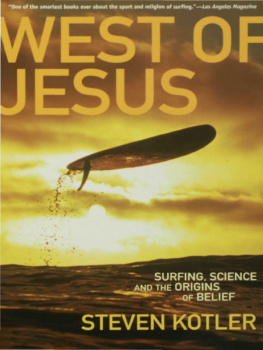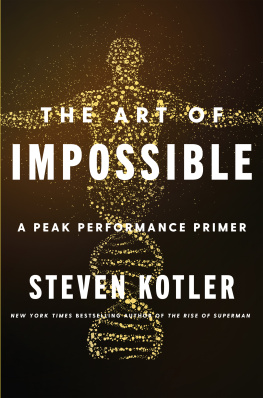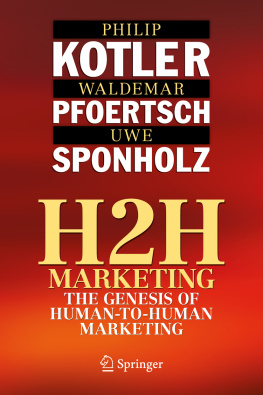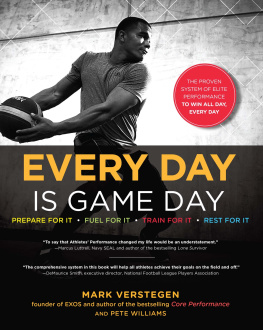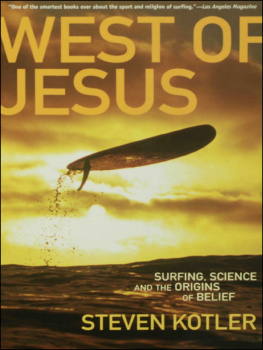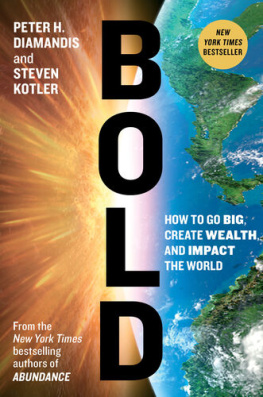

Text copyright 2014 by Steven Kotler
All rights reserved.
No part of this work may be reproduced, or stored in a retrieval system, or transmitted in any form or by any means, electronic, mechanical, photocopying, recording, or otherwise, without written permission of the publisher.
Published by Amazon Publishing, Seattle
www.apub.com
Amazon, the Amazon logo and Amazon Publishing are trademarks of Amazon.com, Inc. or its affiliates.
eISBN: 9781477850831
Cover design by Dave Stanton
Author photograph Ryan Heffernan
Cover art Scott Serfas
Contents
The tools for managing paradox are still undeveloped.
KEVIN KELLY
Preface: The Why of Flow
This is a book about the impossible, but it starts with the invisible. Over the past three decades, an unlikely collection of men and women have pushed human performance farther and faster than at any other point in the 150,000-year history of our species. In this evolutionary eyeblink, they have completely redefined the limits of the possible. But heres the stranger part: this unprecedented flowering of human potential has taken place in plain sight, occasionally with millions of people watchingyet almost no one has noticed.
The reason for this is simple: virtually all of this massively accelerated performance has occurred within the world of action and adventure sports. Certainly, surfing and skiing make for good recreation, and the X Games look excellent on TV, but when it comes to riding 100-foot waves and hucking 100-foot cliffs, most of us see daredevil magic: unfathomable stunts, insane athletesenough said.
Yet what appears to be impossible is actually progressive. Behind each of these feats is a litany of small steps: history, technology, trainingand not just physical training, mental training as well. Success in these danger-fueled activities requires incredible psychological and intellectual talents: grit, fortitude, courage, creativity, resilience, cooperation, critical thinking, pattern recognition, high-speed hot decision makingon and on, and all under some of the most extreme conditions imaginable. Researchers recently coined the phrase Twenty-First-Century Skills to describe those myriad abilities our children need to thrive in this centuryabilities not currently taught in school, but desperately needed in society. Action and adventure sports demand them all.
Yet even this is just the beginning. Of all the things these athletes have accomplished, nothing is more impressive than their mastery of the state known to researchers as flow. Most of us have at least passing familiarity with flow. If youve ever lost an afternoon to a great conversation or gotten so involved in a work project that all else is forgotten, then youve tasted the experience. In flow, we are so focused on the task at hand that everything else falls away. Action and awareness merge. Time flies. Self vanishes. Performance goes through the roof.
We call this experience flow because that is the sensation conferred. In flow, every action, each decision, leads effortlessly, fluidly, seamlessly to the next. Its high-speed problem solving; its being swept away by the river of ultimate performance. Flow naturally catapults you to a level youre not naturally in, explains Harvard Medical School psychiatrist Ned Hallowell. Flow naturally transforms a weakling into a muscleman, a sketcher into an artist, a dancer into a ballerina, a plodder into a sprinter, an ordinary person into someone extraordinary. Everything you do, you do better in flow, from baking a chocolate cake to planning a vacation to solving a differential equation to writing a business plan to playing tennis to making love. Flow is the doorway to the more most of us seek. Rather than telling ourselves to get used to it, thats all there is, instead learn how to enter into flow. There you will find, in manageable doses, all the more you need.
Flow is an optimal state of consciousness, a peak state where we both feel our best and perform our best. It is a transformation available to anyone, anywhere, provided that certain initial conditions are met. Everyone from assembly-line workers in Detroit to jazz musicians in Algeria to software designers in Mumbai rely on flow to drive performance and accelerate innovation. And its quite a driver. Researchers now believe flow sits at the heart of almost every athletic championship, underpins major scientific breakthroughs, and accounts for significant progress in the arts. World leaders have sung the praises of flow. Fortune 500 CEOs have built corporate philosophies around the state. From a quality-of-life perspective, psychologists have found that the people who have the most flow in their lives are the happiest people on earth.
Put differently, a recent Gallup survey found that 71 percent of American workers were not engaged or actively disengaged from their jobs. Think about this for a moment: two out of three of us hate what we do with the majority of our time. This is a crisis of commerce, to say the least. Yet we already know where the solution lies. The other 29 percent of workers have jobs that generate flow. Flow directly correlates to happiness at work and happiness at work directly correlates to success. As CNN recently reported: A decade of research in the business world proves happiness raises nearly every business and educational outcome: raising sales by 37 percent, productivity by 31 percent, and accuracy on tasks by 19 percent, as well as a myriad of health and quality-of-life improvements.
Yet theres a rub. Flow might be the most desirable state on earth; its also the most elusive. While seekers have spent centuries trying, no one has found a reliable way to reproduce the experience, let alone with enough consistently to radically accelerate performance. But this is not the case with action and adventure sports athletes. Quite simply, the zone is the only reason these athletes are surviving the big-mountains, big waves, and big rivers. When youre pushing the limits of ultimate human performance, the choice is stark: its flow or die.
Ironically, this is very good news. Scientists have lately made enormous progress on flow. Advancements in brain-imaging technologies like fMRI and consumer quantified self devices like the Nike Fuel band allow us to apply serious metrics where once was merely subjective experience. Until now, theres been no way to tie all this disparate information together, but recent events in action and adventure sports solve this problem. Knowing that survival demands flow gives us a hard data set with which to work. We dont have to wonder if our research subjects are really in flow: if they live through the impossible, we can be certain. Moreover, by mapping this new science onto these extreme activities, we can start to understand exactly how flow works its magic. Finally, if we can figure out exactly what these athletes are doing to reliably reproduce this state, then we can apply this knowledge across the additional domains of self and society.
In other words, despite the unusual them at the center of this story, this book is really about us: you and me. Who doesnt want to know how to be their best when it matters most? To be more creative, more contented, more consumed? To soar and not to sink? As the deeds of these athletes prove, if we can master flow, there are no limits to what we can accomplish. We are our own revolution.
looks at the darker side of flow, wider cultural impacts, and the future.
The great civil rights leader Howard Thurman once said, Dont ask what the world needs. Ask what makes you come alive. Because what the world needs most is more people who have come alive.
Next page

